Tragedy Strikes
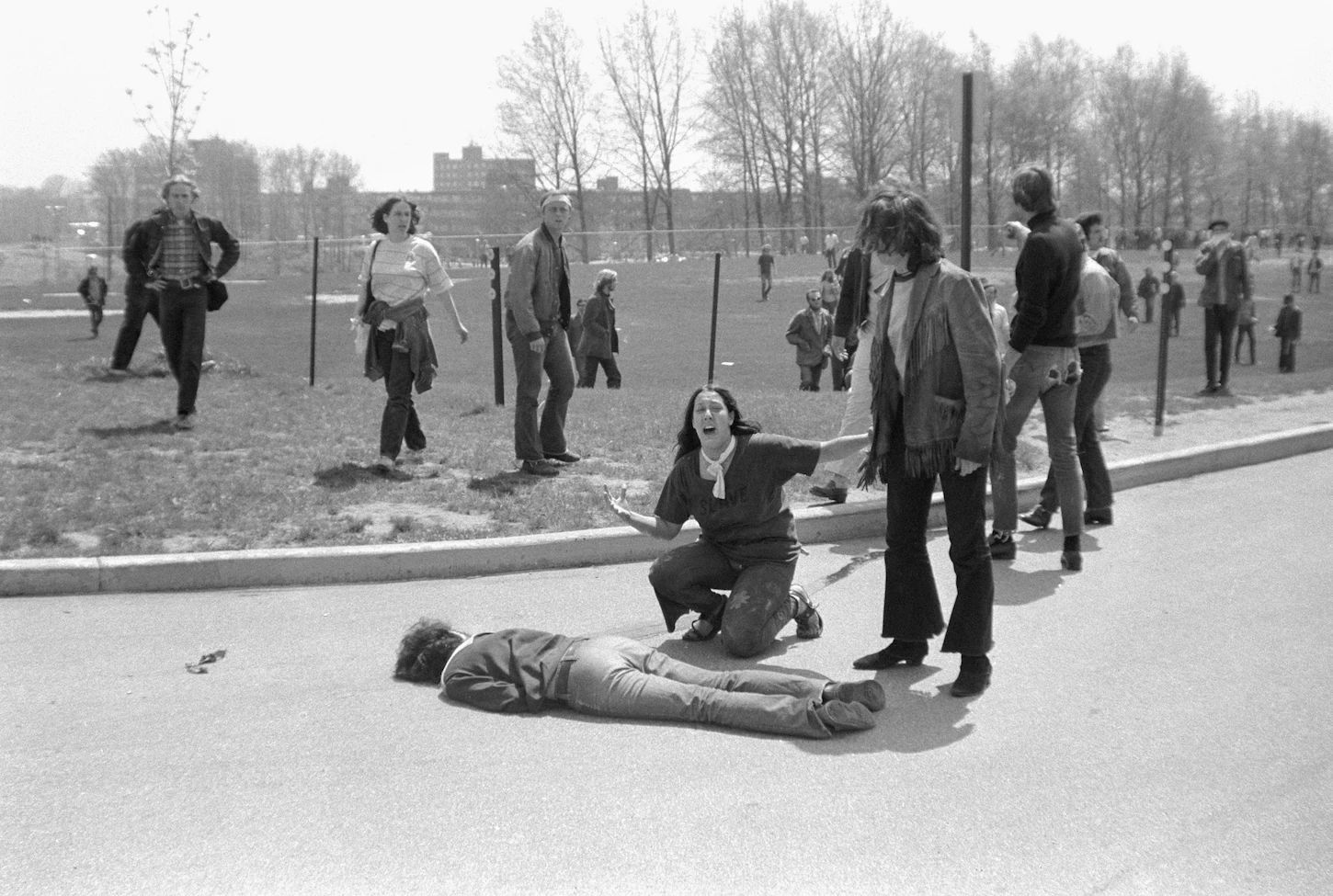
Kent State University
On April 30, 1970, Nixon announced his expansion of the war into Cambodia. Campus demonstrations across the country surged immediately after. Like other college campuses, Kent State University in Ohio was home to a growing anti-war movement, and students planned to gather en masse to demand peace.
It was here at Kent State where tensions between supporters of the war and activists against it came to a violent head. On May 4, 1970, an estimated 2,000 students who had gathered on a campus green for a protest were met by members of the National Guard, called in by Ohio governor James Rhodes.
Ordered to disassemble the crowds, the guardsmen clashed with students proclaiming their right to freely assemble. They threw tear gas, but students remained. Armed only with rocks—which some threw at the Guard—students faced soldiers armed with rifles.
Standing at least 60 years from the students, the National Guard suddenly opened fire into the crowd, killing four students and injuring several others, one of whom was permanently paralyzed. When the smoke had cleared, the National Guard had fired sixty-seven shots in thirteen seconds, and students Allison Krause, Jeffrey Miller, Sandy Scheuer, and William Shroeder lay dead.
Just three days before the massacre, President Richard Nixon publicly referred to university students opposed to the war as "bums." It was a statement that served to inflame public sentiments about anti-war student activists, and for many, set the stage for the violent reactions that were to come.
"You see these bums, you know, blowing up the campuses. Listen, the boys that are on the college campuses today are the luckiest people in the world, going to the greatest universities, and here they are burning up the books, I mean storming around about this issue."
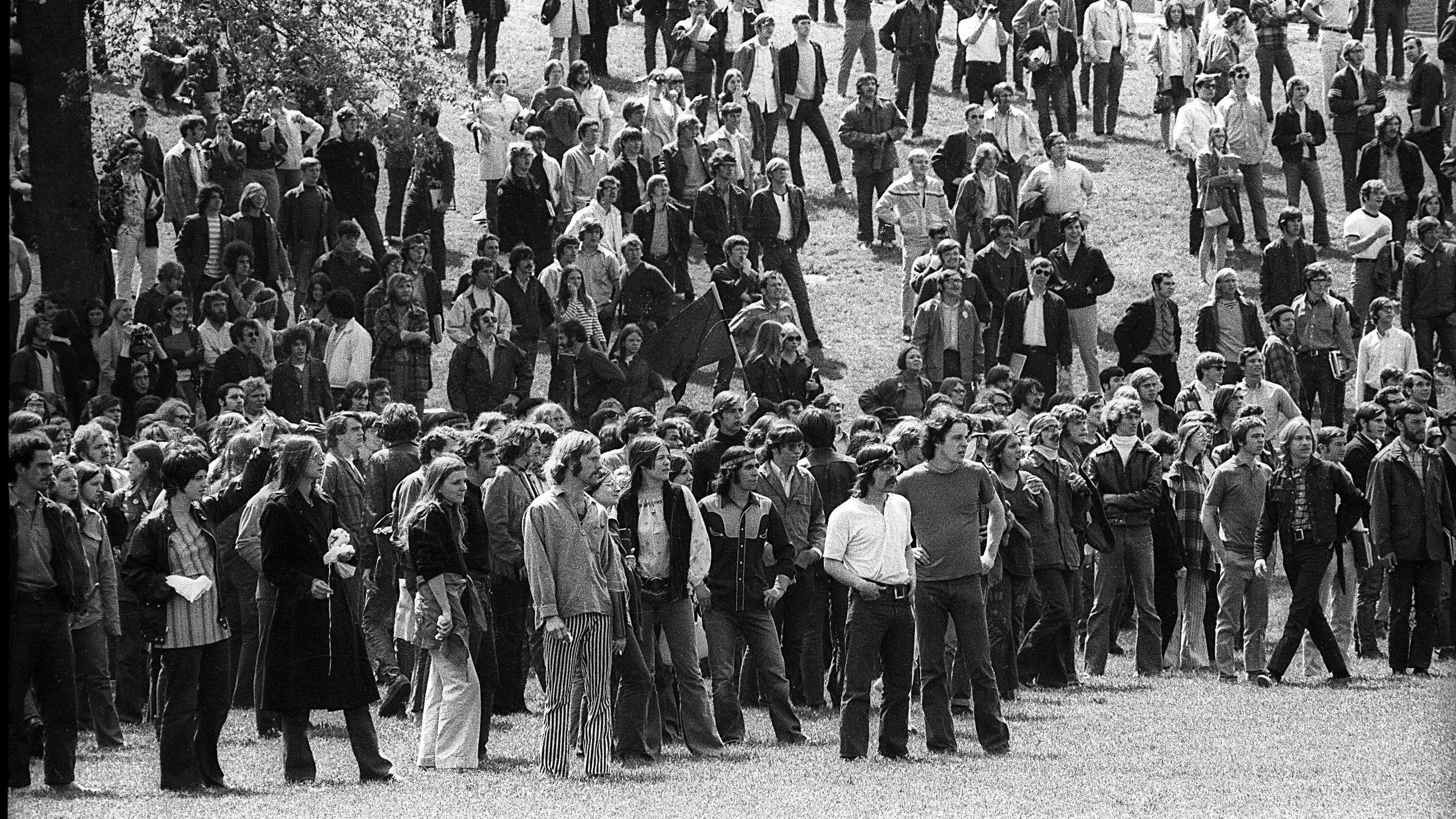
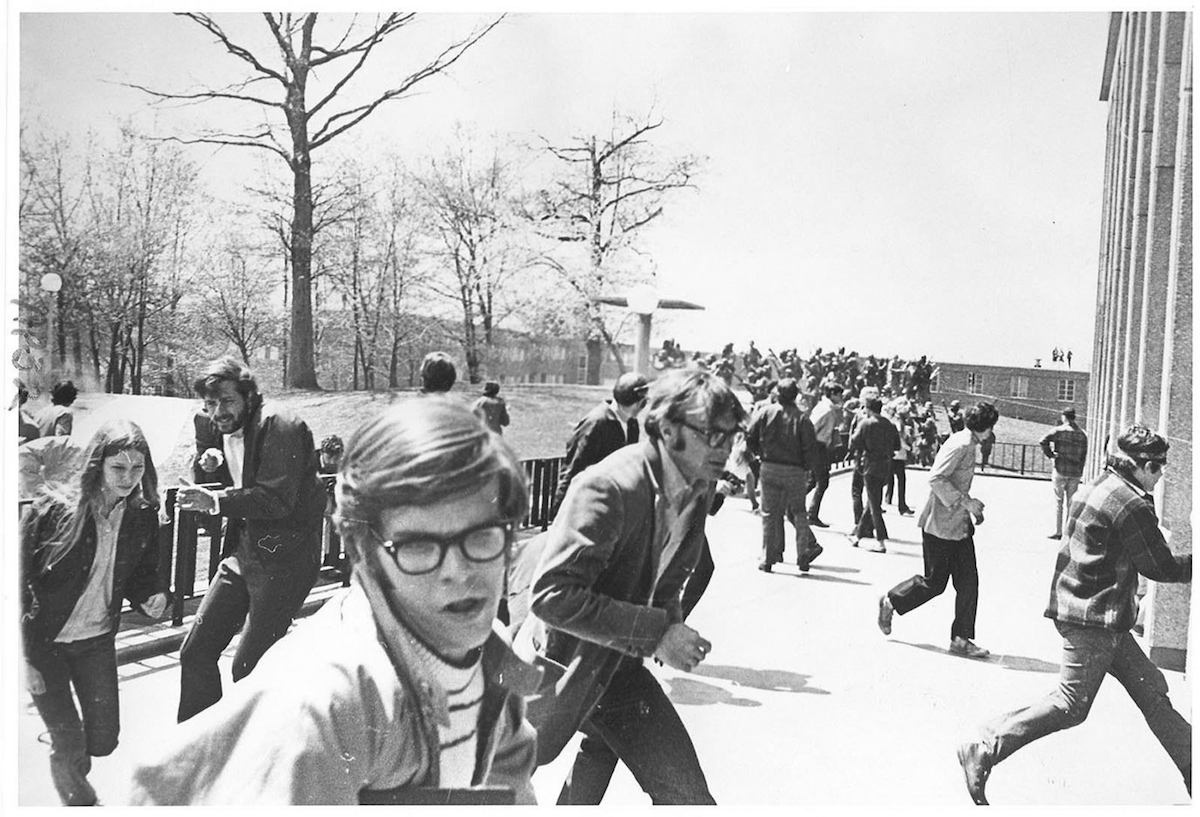
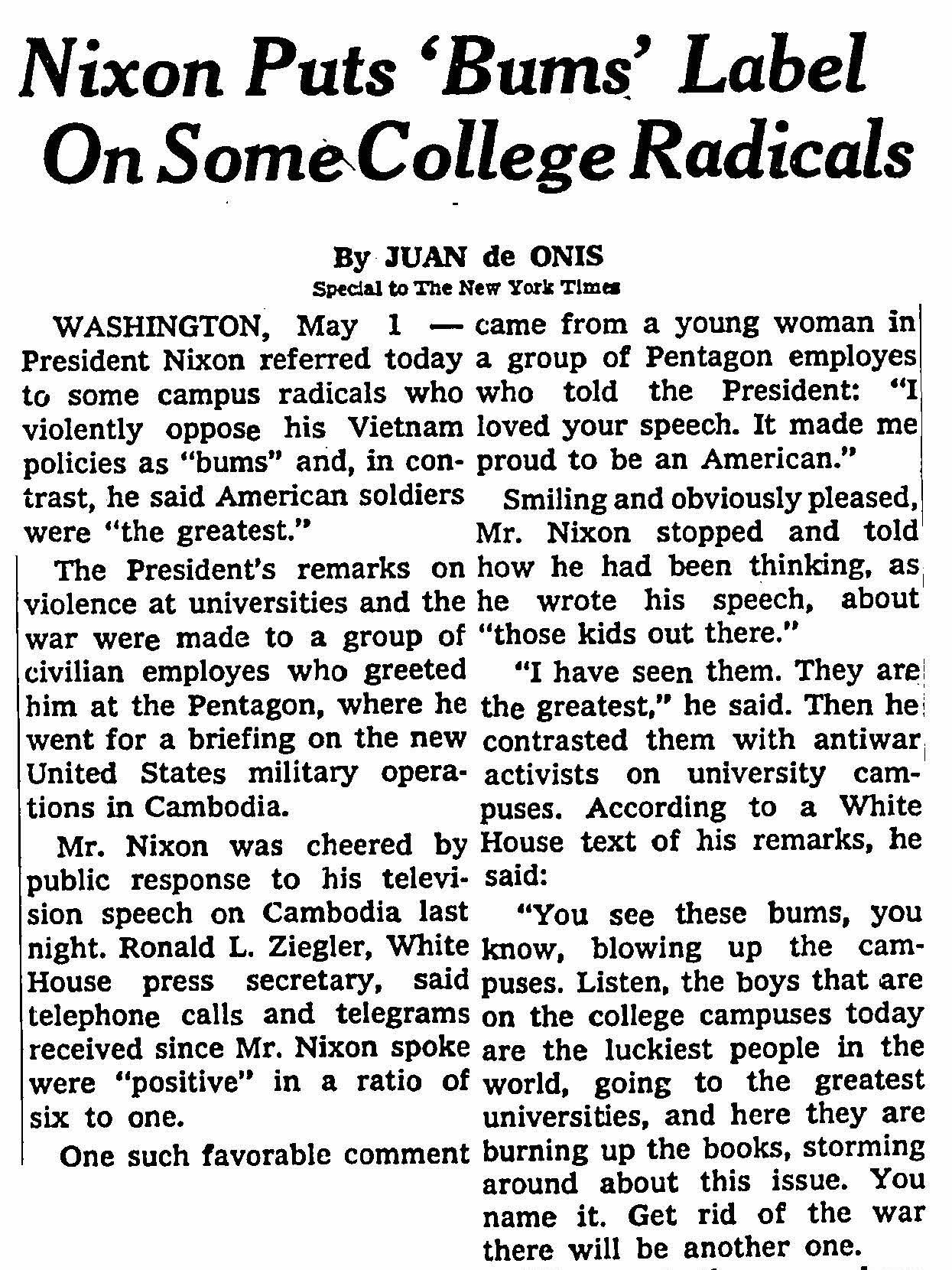
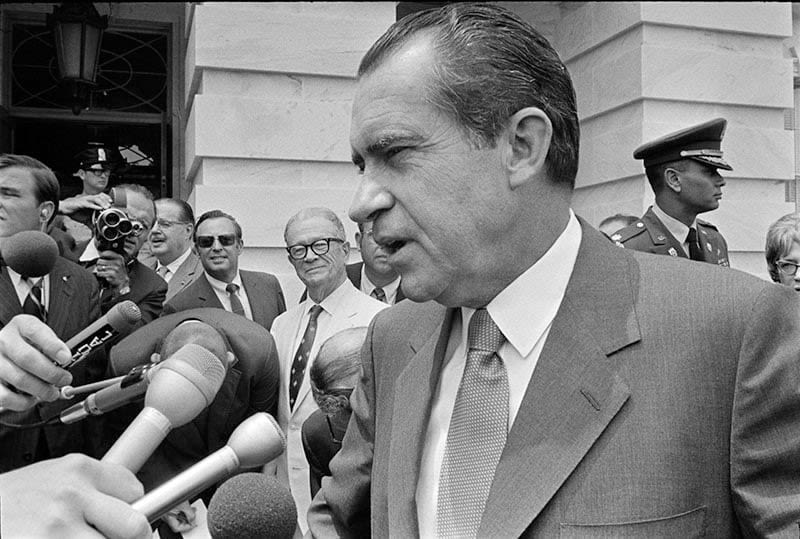
Jackson State
Just ten days after the Kent State shootings, two students at Jackson State College in Mississippi were killed by state police, in circumstances that were eerily similar.
Reaction to the Kent State shootings began on May 12th, 1970, at Jackson State, as students began to collectively gather in peaceful protests. However, the pre-existing racial tensions of the region escalated the mood as white citizens yelled racial slurs at Black student demonstrators. On May 14th, 1970, when law enforcement tried to diffuse the crowd, protesters voiced their own slurs and threw rocks. In response, Mississippi state police officers fired 460 rounds in forty-two seconds, killing students Phillip Gibbs and James Earl Green and wounding 12 others.
Officers claim a sniper had shot at them, but no evidence of this was ever found. Witnesses said the sound of a bottle shattering on the concrete may have been what they heard. Officer’s accounts of the size of the crowd at the demonstration also differed from what witnesses' recount, with police saying the crowd topped 400, while witnesses estimated only 75-100 people.
Although some were gathering in response to the Kent State shootings, other Jackson State students were at the demonstration to advocate for social and racial justice, as they had in previous years (1963-64 and 1967-69). With a predominately Black student population and located in a White suburban neighborhood, Jackson State was already home to racial tensions.
The conflict of May 14th, 1970, escalated, as white citizens moved through those students gathered, but also supports those who argue that Kent State, or even the anti-war sentiments of the Vietnam War, were not the motivating force to the protests that day.

Student, Carl Griffin (center) describing scene of shooting at the girl's dormitory at Jackson State on May 14th, 1970,
Student, Carl Griffin (center) describing scene of shooting at the girl's dormitory at Jackson State on May 14th, 1970,
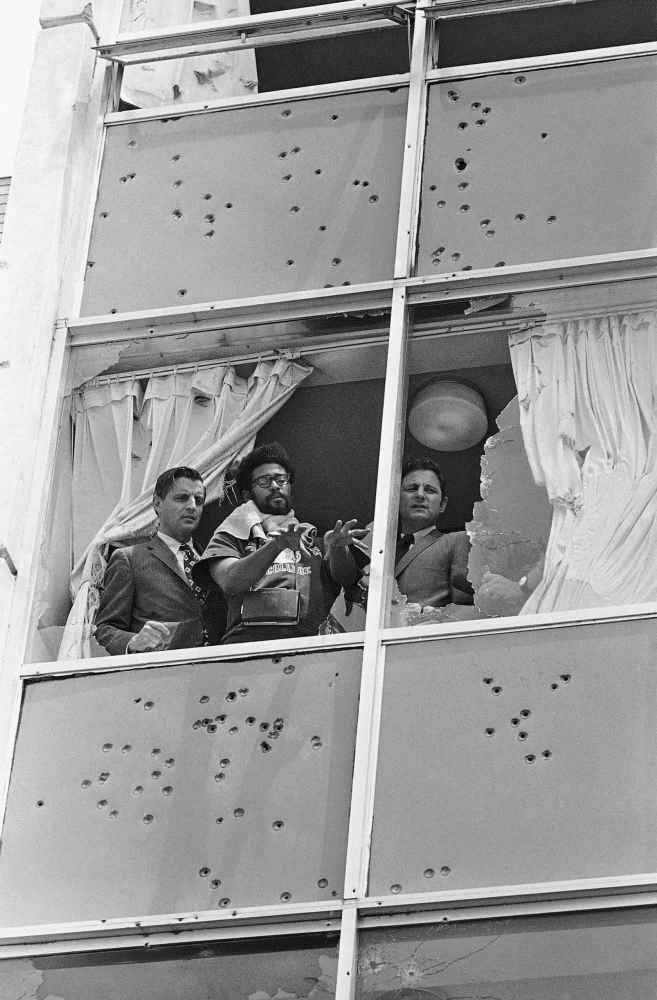
Student, Carl Griffin (center) describing scene of shooting at the girl's dormitory at Jackson State on May 14th, 1970,
Student, Carl Griffin (center) describing scene of shooting at the girl's dormitory at Jackson State on May 14th, 1970,

A., Tyner, James, and Mindy Farmer. Cambodia and Kent State : In the Aftermath of Nixon’s Expansion of the Vietnam War, The Kent State University Press, 2020. ProQuest Ebook Central, https://ebookcentral.proquest.com/lib/uwec/detail.action?docID=6133754.
A., Tyner, James, and Mindy Farmer. Cambodia and Kent State : In the Aftermath of Nixon’s Expansion of the Vietnam War, The Kent State University Press, 2020. ProQuest Ebook Central, https://ebookcentral.proquest.com/lib/uwec/detail.action?docID=6133754.


UWEC Students React
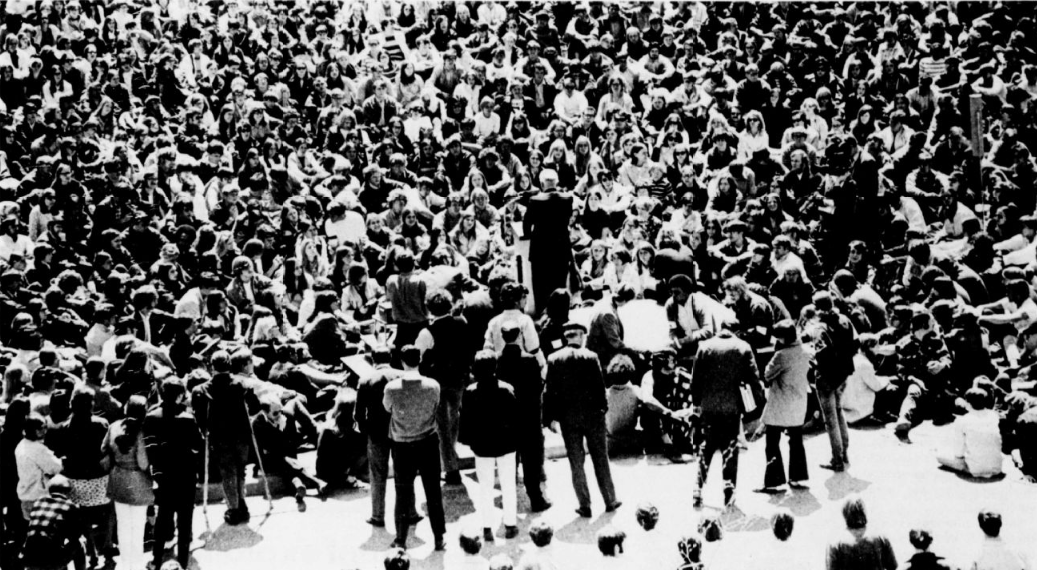
“We’re here because we have an emotional regard for human life…because the killing of the Kent Four…and in disgust for America’s latest Gross National Product – the Indochina War.”

UWEC students sitting in silence at the May 6, 1970 rally for the Kent Four. The Spectator May 14, 1970.
UWEC students sitting in silence at the May 6, 1970 rally for the Kent Four. The Spectator May 14, 1970.
Kent State: the Strike Begins
Almost immediately after the massacre at Kent State, students at UWEC reacted through protest. Strike leaders declared a boycott of classes, with two-thirds of students in general-ED and liberal arts classes participating. On May 6, 1970, 3,000 students and faculty attended a rally on the lawn behind the Davies Center, which addressed the students' motivations and framework of the strike. That evening, 2,000 student and faculty protesters marched from upper campus to the U.S. Army Reserve Center and held another demonstration. After the end of a long day, the protesters finished by collecting trash from around the city and created an impromptu “memorial” to the slain Kent State students.
Never Forget
The next day, around 1000 students and faculty marched from campus to the Federal Building in downtown Eau Claire to sit on the front lawn to protest the death of the Kent State four, as well as the Vietnam War overall. Mourning the dead, activists lowered the American flag outside the building to half-mast and held a four-minute vigil. The following day (May 8), UWEC administrators oversaw the planting of four crabapple trees near the Davies Center in memory of Allison Krause, Jeffery Glen Miller, Sandra Lee Scheuer, and William Knox Schroeder.
"Marching Is Easy"
Despite this passionate response, the strike ended after only a week, with some protesters accusing students of apathy and half-hearted commitment and stating that the protest fell short of its goals. “Where were you…?” a letter written to the editor of The Spectator a week after the strike, contained a scathing rebuke to students who only gave superficial support for the strike, saying “Where were you? Marching once or twice does not mean you have “done your thing” for the cause. Marching does not mean participation in the strike. Marching is easy. Anyone can be a face in the crowd, there is no involvement in that.”
Jackson State: Rallying for the Victims
Mere hours after the shooting at Jackson State University, a rally was held outside Schofield Hall on the UWEC campus where a crowd of around 750 people listened to speakers including both students and professors. The speakers condemned both the killings at Kent State University and Jackson State University, while attacking the role of the United States in the war in Vietnam and Cambodia. Taking part in the speeches, Carlos Lake, on behalf of the Black Coalition, announced the establishment of the Jackson State Medical Fund, a fund that would help to pay the medical bills of those injured in the Jackson State shooting.
“We are tired of marching…tired of talking…we realize the students injured need help. This will be our expression to them of the way we feel.”
- Carlos Lake, Spokesperson for the UWEC Black Coalition. The Spectator May 14, 1970.
While establishing a fund to help the victims of Jackson State was a triumph for activists, many thought there was much more to be done. A group of around twenty students had planned a sit-in demonstration in UWEC President Leonard Haas's office, with the hopes he would allocate university funding to the Jackson State Medical Fund. However, these plans were abandoned, after Haas stated he did not have authority to distribute state funds to the cause. Other students thought that the rallies and strikes in response to Kent State and Jackson State had not been enough. One student, writing to The Spectator called the strikes a “soft punch” and feared the public would soon forget the injustices done.
"The students at Eau Claire wanted a strike, and one was called. It lasted two days, with limited success. It wasn’t a strike, just a soft punch."
- Paul Cohen, Editorial in The Spectator May 21, 1970.
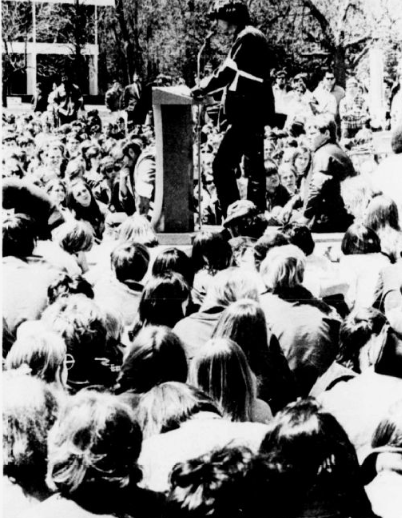
Randy Surbaugh addresses the crowd at the first strike meeting at UWEC. The Spectator, May 14, 1970
Randy Surbaugh addresses the crowd at the first strike meeting at UWEC. The Spectator, May 14, 1970
Voices from the Eau Claire Community
Bridge the Fear
The Kent State and Jackson State shootings inspired short-lived bouts of student protests on UWEC’s campus. However, the Kent State protests' effect permeated the Eau Claire community. Community Interaction was a new student group created to involve the permanent Eau Claire residents in anti-war and peace conversations with students. According to one of Community Interaction’s founders, Luise Forseth, “The community is scared of the University- afraid of riots and disturbances. Since we (students) are an integral part of the community, there should be some communication between us on these and other issues.” Members of UWEC’s Community Interaction went door to door and interviewed 250 residents.

The morning after Jackson police opened fire on the Jackson State College campus, killing two and injuring twelve, two Jackson State students, look out from a window of the female dorms riddled with police bullet holes. Wisconsin State Journal, May 16, 1970.
The morning after Jackson police opened fire on the Jackson State College campus, killing two and injuring twelve, two Jackson State students, look out from a window of the female dorms riddled with police bullet holes. Wisconsin State Journal, May 16, 1970.

Blood flows from one of the Kent State victims, after the Ohio National Guard discharged 67 rounds of live ammunition into a crowd of student anti-war protestors, killing four and injuring nine. The Eau Claire Leader, May 5, 1970.
Blood flows from one of the Kent State victims, after the Ohio National Guard discharged 67 rounds of live ammunition into a crowd of student anti-war protestors, killing four and injuring nine. The Eau Claire Leader, May 5, 1970.
“The only way to get rid of communists is to kill them, and that goes for students too.”
- Eau Claire resident, May 11, 1970 while speaking with Community Interaction.
The Residents Speak
Community Interaction received mixed responses from residents. One resident stated, “We should go in there (Vietnam) and bomb them out at once like we did in WWII, which I have witnessed.” Some residents believed that the student protests were inspired by Communism, while others sympathized with the students' position but did not believe the protests would accomplish much. Such sentiments are reflective of the national response to the anti-Vietnam War movement and Kent State.
What About Jackson?
On both a local and national level, the Jackson State shooting response proved more muted. UWEC students, including the son of Secretary of Defense Melvin Laird, John Laird held a small protest on May 15, 1970, for the two African American students killed and twelve injured by an all-white police force at Jackson State College. The gathered students rang bells every twelve minutes in honor of the students injured by the Jackson police until midnight. The momentum of the movement ended soon after in Eau Claire and across the country. Why was Jackson State consigned to the background of the memory of May 1970?
“We don’t want to let them tear down these scars.”
- Jackson State College student, May 14, 1970 after filing suit in U.S. District Court for a restraining order that prohibited state officials from removing evidence of the Jackson State shooting.

UWEC students gather outside Schofield Hall on campus, including John Laird, son of Defense Secretary Melvin Laird to ring bells in honor of the Jackson State shooting.
UWEC students gather outside Schofield Hall on campus, including John Laird, son of Defense Secretary Melvin Laird to ring bells in honor of the Jackson State shooting.